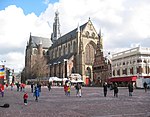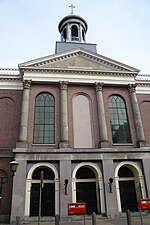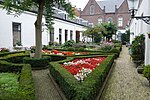St. Barbara Gasthuis

The St. Barbara Gasthuis was a hospital and later a hofje on the Jansstraat in Haarlem, Netherlands. All that remains is a former gateway. It was founded in 1435 by Hugo van Assendelft according to a chronogram written on the gate built in 1624 by Lieven de Key: "OM dat WII oVt ende behoeftICh sChenen VerLatenHeeft HVgo Van AffendeLf hIer gestICht tonfer baten" The capitalized letters that are Roman numerals (the W is read as VV) results in a list of Roman numerals that when added up give the year of establishment of the hospital 1 x M + 3 x C + 2 x L + 6 x V + 5 x I = 1435. As the hospital functions in later centuries were consolidated at the St. Elisabeth Gasthuis, the former hospital became a hofje, which later was abandoned and became derelict. The old hofje was torn down in 1845, leaving the old gateway as a memorial. Address: Janstraat 54, Haarlem
Excerpt from the Wikipedia article St. Barbara Gasthuis (License: CC BY-SA 3.0, Authors, Images).St. Barbara Gasthuis
Jansstraat, Haarlem
Geographical coordinates (GPS) Address Nearby Places Show on map
Geographical coordinates (GPS)
| Latitude | Longitude |
|---|---|
| N 52.382177777778 ° | E 4.6378 ° |
Address
Episode
Jansstraat 52
2011 RZ Haarlem (Haarlem)
North Holland, Netherlands
Open on Google Maps










